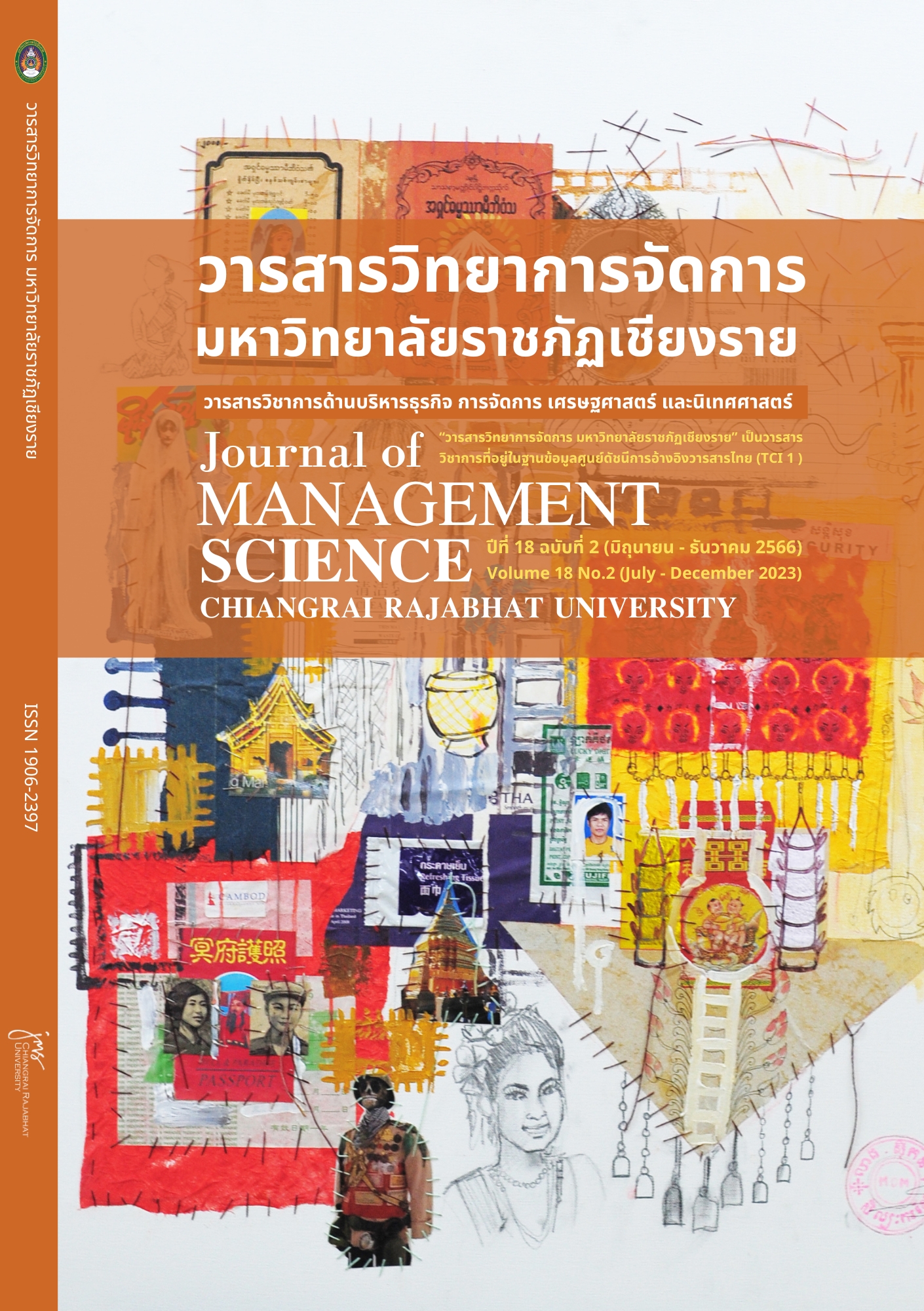Factors Affecting New Normal Behaviour and the Interests in Creative Tourism of South Asian Region Among Thai Tourists
Main Article Content
Abstract
This research paper aims to investigate the factors affecting ‘New Normal’ behaviour and the interests in creative tourism in the South Asian region among Thai tourists. A quantitative method was adopted. The online survey research with one-shot descriptive study was implemented to collect data from two groups of individuals, according to their prior travelling experience, who either have been to countries in South Asia, or have never been to South Asia, but intend to visit countries in South Asia in the next 5 years. In total, 391 responses were received and considered valid for analysis. The findings revealed that characteristics of destination and service-related factors were the most important considerations, whereas social factors were the least important considerations in the opinions of Thai tourists, regardless of the traveling experience. Furthermore, it was found that the interest in creative tourism between two identified groups of tourists, was different in five activities with the significant level of .05. To create opportunities for creative tourism in the South Asian region among Thai tourists, suggestions have been included: to design communication campaigns according to the travelling experience; to attract experienced tourists with new routes and experiences from creative tourism; and to attract inexperienced tourists with memorable and ‘Instagrammable’ experiences.
Article Details

This work is licensed under a Creative Commons Attribution-NonCommercial-NoDerivatives 4.0 International License.
Views and opinions expressed in the journal do not necessarily reflect those of the editors.
References
Ministry of Tourism. (2019). India Tourism Statistic 2019. Retrieved May 20, 2021, from http://tourism.gov.in/sites/default/files/2020-04/India%20Tourism%20Statistics%202019.pdf
Madden, C. (2020). Euromonitor predicts digital, frictionless future for travel industry. DFNI Frontier. Retrieved June 25, 2021, from https://www.dfnionline.com/latest-news/euromonitor-predicts-digital-frictionless-future-travel-industry-01-07-2020/
NapoleanCat. (2021). Instagram users in Thailand: August 2021. Retrieved November 30, 2021 from https://napoleoncat.com/stats/instagram-users-in-thailand/2021/08/
National Bureau of Statistics. (2019). Table 10.1: Flow of Tourists by Nationality, 2016 – 2019. Retrieved May 25, 2021, from http://statisticsmaldives.gov.mv/yearbook/2020/wp-content/uploads/sites/7/2020/09/10.1.pdf
Nunnally, J. C. (1978). Psychometric theory (2nd ed.). New York: McGraw-Hill.
Pearce, P. L. (2005). Tourist behaviour: Themes and conceptual schemes. Clevedon, England: Channel View Publication
Proyrungroj, R. (2015). Tourist Behaviour [in Thai]. Bangkok: Odeanstore.
Richards, G. (2011). Creativity and tourism: the state of the art. Annals of Tourism Research, 38, 1225-1253.
Richards, G. (2013). Tourism development trajectories: From culture to creativity? In M. Smith & G. Richards (Eds.), The Routledge handbook of cultural tourism (pp.297-303). Oxon: Routledge.
Schmöll, G. A. (1997). Tourism Promotion: Marketing background, promotion techniques and promotion planning methods. London: Tourism International Press.
Silpjaru, T. (2005). The research and statistical analysis with SPSS. [in Thai]. Bangkok: V Interprint Co., Ltd.
Siwamokelukkana, J. & Suebbook, P. (2020). Thinking Corner and Future Tourism. Creative Thailand. Retrieved July 15, 2021, from https://www.creativethailand.org/article/howto/32512/th?fbclid=IwAR1amfuJXH8QeZCbwdw4kZ9WbiAEvQaoC7wx8jM9ufhtf63CThAsJyx6ZDs#RC-July-20
Sri Lanka Tourism Development Authority. (2019). Annual Statistical Report 2019 (Provisional Release). Retrieved May 21, 2021, from https://sltda.gov.lk/storage/common_media/AAnnual%20Statistical%20Report%20new%202109%20Word3889144215.pdf
Swarbrooke, J. & Horner, S. (2007). Consumer Behaviour in Tourism (2nd ed). Oxford, UK: Elsevier.
Tourism Council of Bhutan. (2019). Bhutan Tourism Monitor 2019. Retrieved May 23, 2020, from https://www.tourism.gov.bt/uploads/attachment_files/tcb_ K11a_BTM%202019.pdf
United Nations Educational, Scientific and Cultural Organization. (n.d.). World Heritage List. Retrieved August 22, 2020, from https://whc.unesco.org/en/list/&order=region
United Nations World Tourism Organization. (2019). International Tourism Highlights, 2019 Edition. Retrieved July 5, 2021, from https://doi.org/10.18111/9789284421152
World Economic Forum. (2019). The Travel and Tourism Competitiveness Report 2019: Travel and Tourism at a tipping point. Retrieved December 21, 2021, from http://www3.weforum.org/docs/WEF_TTCR_2019.pdf
Zuluaga, D. & Guerra, D. (2021). A typology of creative travelers in Bogota, Columbia: The experience of 5 Bogota. In N. Duxbury, S. Albino, and C.P. Carvalho (Eds), Creative Tourism: Activating Cultural Resources and Engaging Creative Travellers (pp 15-25), Oxfordshire, CABI.


